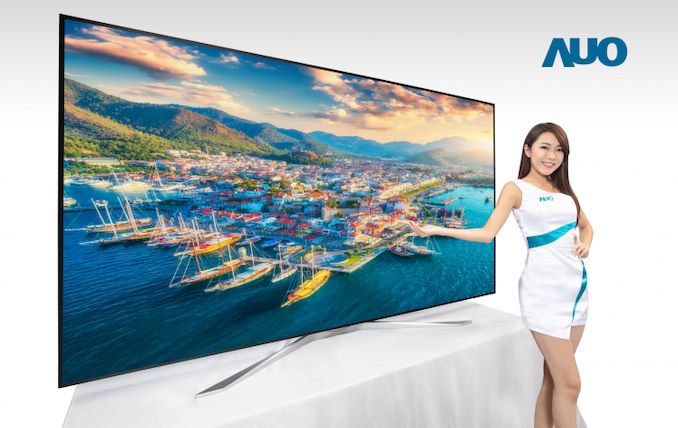AU Optronics's New 85-Inch 8K LCD TV with 1,024-Zone Backlighting
by Anton Shilov on August 28, 2019 9:00 AM EST- Posted in
- Monitors
- Displays
- 8K
- HDR
- AU Optronics

AU Optronics this week showcased a prototype of its most advanced 8K Ultra-HD display featuring an innovative full-area local dimming (FALD) backlighting solution and peak brightness of 2,000 nits. At present, the screen is a proof of concept and AUO does not make any promises regarding its commercial availability of this unit, but it might migrate into a consumer product in the future.
AUO’s most advanced Ultra-HD ALCD TV display relies on an 85-inch panel featuring a 7680×4320 resolution and peak brightness of 2,000 nits. The device has a FALD backlighting with 1,024 zones, so contrast ratios supported by the monitor should be very high. Unfortunately the press release has no word about maximum refresh rate and other features, except that the 8K UHDTV prototype supports high dynamic range, but AUO does not disclose the exact type.
AU Optronics says that its 8K panel with a 1,024-zone FALD backlighting can be mass produced, but says nothing about its price or potential availability timeframe. Considering the fact that 85-inch 8K LCD panels cost a lot and FALD is very expensive in general, we expect UHDTVs based on AUO’s 85-inch 8K panel with FALD to be extremely pricey. As for approximate ETA date, many makers of 8K televisions and panels plan to offer their next-generation products in time for 2020 Tokyo Olympics.
Related Reading
- AUO to Ship 8K UHD TV Panels in Coming Months
- Realtek Demonstrates RTD2893: A Platform for 8K Ultra HD TVs
- Sharp Demonstrates 31.5-Inch 8K 120Hz HDR Monitor
- Samsung's 2019 QLED UHD TVs: 8K TVs Revamped, 4K TVs Get New Panel & Backlighting
- Samsung Starts to Take Pre-Orders on 85-Inch Q900 8K UHDTV
Source: AU Optronics










11 Comments
View All Comments
mooninite - Wednesday, August 28, 2019 - link
LCD... 2019... DOA! Knowing it's AUO it has to mean the panels will have extremely uneven backlight uniformity. I'm guessing $6-7k for something that will look like crap compared to a similar priced 80" OLED.CharonPDX - Wednesday, August 28, 2019 - link
Yeah, "1024 local dimming zones!" - an 8K OLED would have 33,177,600 (or 99,532,800 to 132,710,400) local dimming zones (depending on if you count subpixels and what the subpixel layout is.)ksec - Wednesday, August 28, 2019 - link
Um....... that is assuming AMOLED, not OLED ( WOLED ) used on TV.edzieba - Thursday, August 29, 2019 - link
AMOLED is just a Samsung marketing term for any of their OLED panels. WOLED only differs from other OLED manufacturing processes by the way the subpixels are structured: mobile OLED panels use a different emissive mix for each R, G and B subpixel (requires three sequential deposition steps) whereas WOLED uses the same white mix for every subpixel (single deposition step) and applies a transmissive filter on top to determine what colour each subpixel will emit. This is less power efficient, but is far cheaper to manufacture due to higher yields (and slightly reduces differential colour ageing).shing3232 - Wednesday, August 28, 2019 - link
LCD is not DOA as long as OLED burn-in. LCD would last much longer.edzieba - Thursday, August 29, 2019 - link
Both are competitive in different environments. OLEDs can achieve much better absolute black levels, but maximum brightness is MUCH lower than a FALD-backlit LCD. Contrast can be higher or lower depending on how you measure (e.g. pickingtwo adjacent pixels and comparing 0-level to max-level favours OLED, picking nonadjacent pixels and comparing grey-to-grey contrast massively favours FALD+LCD). For any environment where you cannot completely control external lighting the 'absolute' black of OLED is less of a feature compared to the higher output level and perceptual higher contrast of FALD + LCD.NuclearArmament - Wednesday, August 28, 2019 - link
LCD is perfectly fine, OLED makes no sense as long as LCD monitors like the eCinema with a 20,000:1 static contrast ratio exist. The Sony Z9D, Z9F, Z9G, are proof LCD matches performance of even the best OLEDs at a fraction of the price, and little risk of burn-in comparatively.s.yu - Saturday, August 31, 2019 - link
Um, I don't think Sony's Z9 series is cheaper than LG's OLEDs at the same size, though the Sony has 100" while that's not available for LG. I have an LG OLED and checked out Z9D at a store, I think OLED's deep blacks are more noticeable than Z9D's higher peak brightness, and even with local dimming the blooming is significant enough to be distracting.Santoval - Thursday, August 29, 2019 - link
1024 zones of local dimming sound very low for the size and the resolution of this display. I am too lazy to do the calculations right now, but the pixels and cm^2 each zone covers must be too high.LarsBolender - Sunday, September 1, 2019 - link
Hijacking this post to ask if you will review the Galaxy Note 10(+). Im very interested to see how big the efficiency improvement of the new 7nm EUV node ist compared to the old "8nm" node.